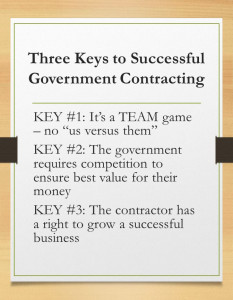Happy holidays everyone! This time of year normally brings so much to look forward to, although it seems John Oliver may disagree this year. It is the time of year to catch up with lost family and friends, tell stories, exchange gifts. Some of us will be traveling. Some will be staying local. Others will be staring at pictures that were taken on white sands of Maui, where Erin and I were drinking Mai Thais just one year ago…but, I digress. This time of year brings another fun past time for the government contractor community – proposal writing.
Now I can almost sense the jealousy in some of you reading this post, but the one benefit that proposal season brings is it provides me and my fellow contracting-brethren insight into the hot new trends in the world of government. As I look across these (digital) mountains of Request for Proposals (RFP)s, I’m noticing a few trends that are concerning to me and I’d like to call attention to.
A couple disclaimers up front. One, although I’m a contractor, I’m going to do my best to look at this from the government’s side. I trust that if I’m too far off, someone out there will step up and show me the error in my ways.
And two, as much as this it would make this article more fun to write, I don’t believe there is any conspiracy going on here. I don’t believe that there was any malicious intend in any of these new trends. I think the government had good intentions with implementing all of these, but I just think that there will be ripple effects downstream that will ultimately make these more trouble than they are worth. And if you think I’m wrong, I’d love to hear why in the comments section.
With that in mind, as I examine these troubling trends, I’ll do a few things. First, I’ll explain what they are and what the government was trying to enforce/prevent/allow. Then I’ll move on to explain why I think they ultimately will do more harm then good, and finally, how they can be corrected.
But before any of that, I want to start by level-setting everyone with what makes for a successful contract.
When do contracts go right?
In my humble opinion, successful contracts happen when three things are kept in mind. I call this my Three Keys to Successful Contracts.
KEY #1: Understand that both sides want the contract to work out. When these things fail, nobody wins. The government wastes money, and the contractors need to find new employment. These agreements cannot be an “us versus them” thing. Upon signing the contract, it must become a team game.
KEY #2: The customer (the Government in this case) needs to get the best value for their money. To do this, competition for their work is not only understandable, but a requirement. And after winning the contract, the contractors should continually look to provide value to their client however they can throughout the life of the contract.
KEY #3: The government should not prevent the contractor from being able to grow a successful business; which includes making a profit off of the work, hiring and being able to retain qualified employees, paying them a competitive salary (with cost of living raises) reminiscent of their work experience, and offering a work/life balance that the employee agrees to.
Sounds easy. Sounds simple. But I’ve seen contracts fail when the sides can’t come together. I’ve seen contracts fail because the contractors tried to screw the government. And I’ve seen contracts fail because the government has driven off all their good support staff, ruining a good business. Ultimately, all three trends that I identify below fail one of these Three Keys.
Trend #1: Capability Model Maturity Integration, or as its friends call it, CMMI
If you don’t know what CMMI stands for, I’ll save you a Google search and provide a link to the Wikipedia page. CMMI is all about a process. Identifying a process. Implementing a process. Following a process and improving the process. And then there is metrics in there to show the goodness of the process. And there are levels to show how far along in the process you are.
It is very regimented. It is very formal. Which the government sees as a good thing.
What does the government want from CMMI?
The government believes that a formalized process, one that has been outlined and verified through the CMMI governing body, will lead to high quality service. And to some extend it does, by weeding out smaller and newer companies. However, I’m not sure that’s entirely a good thing as it weeds out some companies unnecessarily.
Why does CMMI miss the mark?
Because CMMI talks to following a process, whereas support services contracts are really about following the government’s process. If my company documents and follows a process that requires us to submit an Engineering Change Requests (CR) through a musical dance number, how does that help anyone? Besides the obvious blackmail and YouTube submissions that come later or the strengthening of our karaoke team.
And CMMI – they don’t care if you submit CRs via formal process. Or by dance. Or carrier pigeons. All CMMI cares about is that your process is repeatable and that you have proven that you follow it. But in most circumstances, any of the above would be considered incredibly inefficient, and none of it helps the government.
What the government really needs is a team to come in and augment THEIR process. We need to show how we can support how they do business. So from that perspective, who cares if we can follow our own process?
At the end of the day, all that requirement is doing is eliminating potential competition and giving the government less to choose from. And therefore, it fails KEY #2.
How to fix the CMMI requirement?
The government already requires a submission of relevant past performance, which should weed out the same companies that can’t comply with the current CMMI requirements. I’d like to see the government agencies provide their processes to industry, and then ask competing companies to explain who and how we would support. I believe that would give the government a better understanding of if a company could really support their requirements.
Trend #2: Indefinite Delivery / Indefinite Quantity (ID/IQ) for EVERYTHING
Another trend that I’m beginning to see that has me worried is this move away from competing and awarding Task Orders, and instead awarding an ID/IQ contract type with future task orders TBD. For those that don’t know, think of an ID/IQ as a piggy bank that the government requires your business to have access to before it starts depositing coins into it. The coins represent the actual work being competed in the form of Task Orders (TOs). Now, the piggy bank (ID/IQ) itself isn’t worth anything (or much), other than the fact that it lets you compete for and/or acquire the coins (TOs) that are valuable.
Traditionally, piggy banks and coins have been competed separately.
What does the government get for an ID/IQ?
In a word, flexibility. In three words, LOTS of flexibility. It gives the Program Managers (PM) the flexibility to change the scope and direction of the tasks orders they release over the Fiscal Year (FY). Historically, PMs have had issues here because they release multi-year task orders, and then can’t adopt to changes in budget, direction or priorities from FY to FY.
Where does ID/IQ miss the mark?
From the contractor’s perspective, it makes it very difficult to judge and staff the work during the proposal development period. Personally, I firmly believe that purposefully under-scoping the work in order to win a contract and ask for more money later is borderline criminal tactic for contractors to use. However, if this trend continues, I could see a lot of that happening. In this current environment, if you bid high, you lose. Period. And if you lose enough opportunities, you’ll lose more than the opportunity; you’ll lose your job and/or your business.
So when in doubt, contractors are erroring on the low side, which makes it extremely difficult and/or impossible for the organizations to train and retain key talent needed to support the various opportunities. Preventing a contracting company from growing its business and directly violating KEY #3.
What is a better approach to ID/IQ?
I think in this case, there is enough benefit here where it will work itself out over time. This is just a new trend, so naturally there are some wrinkles that need to be worked out. And I’m sure the government will get this feedback through Requests for Clarification (RFCs) and the various Industry Day events they will hold over the next year or so.
My recommendation is to keep the ID/IQ approach, but have the government lay out and agree to all of the task orders for the first six months or first year of the contract. For that duration, the government should know what work it’ll need the contractor to perform, but they’ll still have the ability to change scope and direction in the future. PLUS, that would prevent us contractors from having to apply for various piggy banks without knowing which one the government wants to deposit its coins into – a huge hurdle for us right now.
Trend #3: Is it Best Value or Lowest Price Technically Acceptable (LPTA)?
Trick question – these days, it seems like everything is LPTA.
So, let’s back up. What is Best Value and LPTA?
Best Value and LPTA are different selection processes for awarding a winner for a coin..err, Task Order. Best Value (should) award the work to the team that offers the best overall solution (including technical, management and cost proposals), and LPTA (should) award the work to the team that can handle the work at the lowest price. The issue now is, even the Best Value opportunities are being competed as LPTA.
What causes a perfectly good Best Value contract opportunity to behave like an LPTA?

Author’s approximation of the relationship of an ID/IQ and a Task Order
Two reasons, one is budget. The theory is that the government saves money by hiring contractors that cost less for the same work. A theory which Cindy Wilkins and others have argued on here.
Putting aside that, there is also a legal issue here. The issue is with “how does one define best value?” It is a subjective term that has, on multiple occasions, required the government to go to court to defend its decision. LPTA is much more objective as it’s a simple comparison of numbers. There could be an argument whether the lower proposal is technically acceptable, but it is much more difficult to make. So, another area that the government could be looking to save by awarding LPTA is in legal fees.
Why is this an issue?
It is an issue because it affects how you bid a contract. LPTA you are bidding against exactly what is in the RFP. Nothing else. And you’ll look for the cheapest labor you can get to win the work. And you’ll forego any of the luxuries to get your price point as low as possible.
Best Value, it is all about building the best team and understanding the customer. So you’ll choose the SME with 15 years of experience over the one with 7 because they’ll do a better job. You’ll may throw in some perks that you know the customer needs but weren’t stated to set yourself apart. In Best Value contracts, price is still an issue, it is just not THE ISSUE.
The bidding strategies are completely different. I’m not arguing for one or the other, but I do need to know how to bid the work. Starting out on such an uncertain foundation forces the PMOs and the contracting teams to be at odds from the start. Which flies directly in the face of KEY #1.
How can we make Best Value great again?
Having everyone read Cindy’s article above would be a good start. Other than that, two things comes to mind. One, hold the Contracting Officers (KO) accountable for their selections to ensure that they are selecting winners appropriately. And two, force the Program Management Offices (PMO) and KOs to discuss and sign off on their selection together.
It’s tricky. There is no clear answer. But increased communication between the two would go a long way.
In conclusion – can’t we all just get along?
Yes, of course we can. We’ve all been getting along for a really long time. And we will continue to get along. But that doesn’t mean that we shouldn’t stop and examine the process from time to time to ensure that both sides are getting the most out of the deal.
To bring this back to the beginning – everyone wants a contract to be successful. Everyone wins when good work is completed.






Leave a Reply
You must be logged in to post a comment.